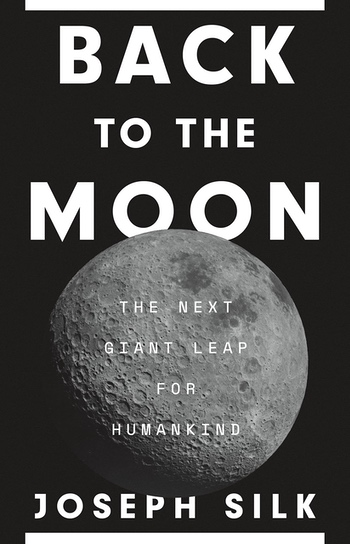Review: Back to the Moonby Jeff Foust
|
| He envisions a future where lunar bases serve as launching pads for expeditions into the solar system as well as mining water and rare earth elements, but what Silk is really interested in is using the Moon as an observatory. |
There’s still a long way to go before humans walk on the Moon again, but that hasn’t stopped people from envisioning giant leaps to come. For some, that involves permanent bases on the Moon where scientists can study the Moon itself. Others envision mining water ice deposits to create fuel for spacecraft to explore the solar system, or to sustain lunar tourist resorts. Or, for people like astrophysicist Joseph Silk, it’s leveraging those efforts to build new observatories for studying the universe.
Back to the Moon, Silk’s new book, starts off with a review of past lunar exploration and ongoing efforts, including both the NASA-led Artemis campaign and Chinese plans. He envisions a future where lunar bases serve as launching pads for expeditions into the solar system as well as mining water and rare earth elements (and even helium-3), and even “giant lunar parks for leisure and recreation.”
It's clear, though, that what Silk is really interested in is using the Moon as an observatory. “Not only could we view the cosmos in a way that currently unimaginable from the Earth, or even from space, but lunar platforms also have the potential to be immensely rewarding for fundamental physics goals,” he writes in the book’s first chapter.
Much of the book is not about lunar exploration or development at all. Several chapters are devoted primarily to discussions of astrophysics concepts, like cosmology and black holes, as well as astrobiology. That’s understandable given his background and his stated interest in developing lunar astronomical facilities, but it still leaves a reader, slogging through sections on the cosmic microwave background and gravitational waves, what all this has to do with going back to the Moon.
What is has to do with the Moon are his concepts for major observatories there, with emphasis on major. One involves “millions of simple radio antennae” deployed over an area more than 100 kilometers across on the radio-quiet lunar farside: “The view from there of the beginning of the Universe would be as good as it ever could be,” he argues. Another is an infrared telescope with a primary mirror 400 meters across built into a crater at the lunar poles to look for evidence of life on expoplanets. Building such a “hyperscope” is largely left as an exercise for the reader.
Silk downplays the expense of a million-antenna array, infrared hyperscope, or other astronomical observatory concepts. He never given any estimated costs for these projects, only arguing that they would be a tiny fraction of the overall expense in setting up any kind of permanent lunar infrastructure. “The beauty of a lunar project is that we are going back to the Moon to develop infrastructure regardless of the cost. Once there, science projects are feasible on scales that are otherwise inconceivable.”
| “The beauty of a lunar project is that we are going back to the Moon to develop infrastructure regardless of the cost. Once there, science projects are feasible on scales that are otherwise inconceivable.” |
There are several flaws in that argument. While observatories may be a small fraction of the overall cost of lunar infrastructure, they will still have a significant absolute cost, which Silk is reticent to even estimate. They will likely be far more expensive than terrestrial observatories, which themselves can be difficult to fund, as astronomers have discovered working on projects like the Giant Magellan Telescope, Thirty Meter Telescope, and Square Kilometer Array.
For the foreseeable future, lunar observatories, at least on the grandiose scale Silk proposes, are not being pursued. The astrophysics community, in the Astro2020 decadal survey published a little more than a year ago, did not prioritize lunar observatories, instead endorsing a series of space telescopes whose development and operations will extend into the middle of the century. A set of 63 objectives published by NASA in September regarding Moon and Mars exploration includes only one related to astrophysics: “Conduct astrophysics and fundamental physics investigations of space and time from the radio quiet environment of the lunar far side.”
Silk himself acknowledges that some of his plans, like the infrared hyperscope, won’t be developed for at least several decades, “but I believe they are inevitable.” In other words, contrary to the book’s subtitle, the observatories he foresees revealing the secrets of the universe from the lunar surface are probably several giant leaps away.
Note: we are using a new commenting system, which may require you to create a new account.
